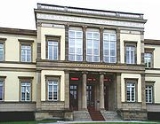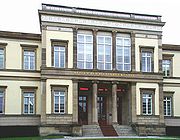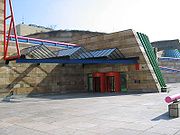
Staatsgalerie Stuttgart
Encyclopedia
The Staatsgalerie Stuttgart (State Gallery) is an art gallery
and art museum in Stuttgart
, Germany
, opened in 1843. In 1984 the opening of the Neue Staatsgalerie
(New State Gallery) designed by James Stirling
transformed the once provincial gallery into one of Europe
's leading museum
s.
 Originally, the classicist
Originally, the classicist
building of the Alte Staatsgalerie was also the home of the royal art school. Built in 1843, it was extended by two further wings during 1881-1887. After being totally destroyed in World War II, it was rebuilt from 1946 and reopened in 1948.
It houses the following collections:

The Neue Staatsgalerie, a controversial architectural design by James Stirling
, opened on March 9, 1984 on a site right next to the old building. It houses a collection of 20th-century modern art
— from Pablo Picasso
to Oskar Schlemmer
, Joan Miró
and Joseph Beuys
.
Art gallery
An art gallery or art museum is a building or space for the exhibition of art, usually visual art.Museums can be public or private, but what distinguishes a museum is the ownership of a collection...
and art museum in Stuttgart
Stuttgart
Stuttgart is the capital of the state of Baden-Württemberg in southern Germany. The sixth-largest city in Germany, Stuttgart has a population of 600,038 while the metropolitan area has a population of 5.3 million ....
, Germany
Germany
Germany , officially the Federal Republic of Germany , is a federal parliamentary republic in Europe. The country consists of 16 states while the capital and largest city is Berlin. Germany covers an area of 357,021 km2 and has a largely temperate seasonal climate...
, opened in 1843. In 1984 the opening of the Neue Staatsgalerie
Neue Staatsgalerie
The Neue Staatsgalerie in Stuttgart, Germany was designed by the British firm James Stirling, Michael Wilford and Associates, although largely accredited solely to partner James Stirling. It was constructed in the 1970s and opened to the public in 1984....
(New State Gallery) designed by James Stirling
James Stirling (architect)
Sir James Frazer Stirling FRIBA was a British architect. He is considered to be among the most important and influential British architects of the second half of the 20th century...
transformed the once provincial gallery into one of Europe
Europe
Europe is, by convention, one of the world's seven continents. Comprising the westernmost peninsula of Eurasia, Europe is generally 'divided' from Asia to its east by the watershed divides of the Ural and Caucasus Mountains, the Ural River, the Caspian and Black Seas, and the waterways connecting...
's leading museum
Museum
A museum is an institution that cares for a collection of artifacts and other objects of scientific, artistic, cultural, or historical importance and makes them available for public viewing through exhibits that may be permanent or temporary. Most large museums are located in major cities...
s.
Alte Staatsgalerie

Classicism
Classicism, in the arts, refers generally to a high regard for classical antiquity, as setting standards for taste which the classicists seek to emulate. The art of classicism typically seeks to be formal and restrained: of the Discobolus Sir Kenneth Clark observed, "if we object to his restraint...
building of the Alte Staatsgalerie was also the home of the royal art school. Built in 1843, it was extended by two further wings during 1881-1887. After being totally destroyed in World War II, it was rebuilt from 1946 and reopened in 1948.
It houses the following collections:
- Old German paintings 1300-1550
- Italian paintings 1300-1800
- Dutch paintings 1500-1700
- German paintings of the baroqueBaroqueThe Baroque is a period and the style that used exaggerated motion and clear, easily interpreted detail to produce drama, tension, exuberance, and grandeur in sculpture, painting, literature, dance, and music...
period - Art from 1800-1900 (romanticismRomanticismRomanticism was an artistic, literary and intellectual movement that originated in the second half of the 18th century in Europe, and gained strength in reaction to the Industrial Revolution...
, impressionismImpressionismImpressionism was a 19th-century art movement that originated with a group of Paris-based artists whose independent exhibitions brought them to prominence during the 1870s and 1880s...
)
Notable works
- Annibale CarracciAnnibale CarracciAnnibale Carracci was an Italian Baroque painter.-Early career:Annibale Carracci was born in Bologna, and in all likelihood first apprenticed within his family...
's Corpse of Christ (1583-1585) - Max BeckmannMax BeckmannMax Beckmann was a German painter, draftsman, printmaker, sculptor, and writer. Although he is classified as an Expressionist artist, he rejected both the term and the movement...
's Journey on the Fish - Salvador DalíSalvador DalíSalvador Domènec Felip Jacint Dalí i Domènech, Marquis de Púbol , commonly known as Salvador Dalí , was a prominent Spanish Catalan surrealist painter born in Figueres,Spain....
's The Raised Instant (1938) - George GroszGeorge GroszGeorg Ehrenfried Groß was a German artist known especially for his savagely caricatural drawings of Berlin life in the 1920s...
's The FuneralThe Funeral (Grosz)The Funeral is a painting by the German Expressionist artist George Grosz completed between 1917 and 1918...
(1918) - Franz MarcFranz MarcFranz Marc was a German painter and printmaker, one of the key figures of the German Expressionist movement...
's The Small Yellow Horses (1912) - Henri MatisseHenri MatisseHenri Matisse was a French artist, known for his use of colour and his fluid and original draughtsmanship. He was a draughtsman, printmaker, and sculptor, but is known primarily as a painter...
's With the Toilet (La Hair-style) (1907) - Joan MiróJoan MiróJoan Miró i Ferrà was a Spanish Catalan painter, sculptor, and ceramicist born in Barcelona.Earning international acclaim, his work has been interpreted as Surrealism, a sandbox for the subconscious mind, a re-creation of the childlike, and a manifestation of Catalan pride...
's The Bird with the Calm View, the Wings in Flames (1952) - Piet MondrianPiet MondrianPieter Cornelis "Piet" Mondriaan, after 1906 Mondrian , was a Dutch painter.He was an important contributor to the De Stijl art movement and group, which was founded by Theo van Doesburg. He evolved a non-representational form which he termed Neo-Plasticism...
's Composition in White, Red and Blue (1936) - Pablo PicassoPablo PicassoPablo Diego José Francisco de Paula Juan Nepomuceno María de los Remedios Cipriano de la Santísima Trinidad Ruiz y Picasso known as Pablo Ruiz Picasso was a Spanish expatriate painter, sculptor, printmaker, ceramicist, and stage designer, one of the greatest and most influential artists of the...
's Tumblers (Mother and Son) (1905), Laufende Frauen am Strand (1922), The Breakfast in the Free One (1961) - Works by: Paul KleePaul KleePaul Klee was born in Münchenbuchsee, Switzerland, and is considered both a German and a Swiss painter. His highly individual style was influenced by movements in art that included expressionism, cubism, and surrealism. He was, as well, a student of orientalism...
, Marc ChagallMarc ChagallMarc Chagall Art critic Robert Hughes referred to Chagall as "the quintessential Jewish artist of the twentieth century."According to art historian Michael J...
, Wassily KandinskyWassily KandinskyWassily Wassilyevich Kandinsky was an influential Russian painter and art theorist. He is credited with painting the first purely-abstract works. Born in Moscow, Kandinsky spent his childhood in Odessa. He enrolled at the University of Moscow, studying law and economics...
Neue Staatsgalerie

The Neue Staatsgalerie, a controversial architectural design by James Stirling
James Stirling (architect)
Sir James Frazer Stirling FRIBA was a British architect. He is considered to be among the most important and influential British architects of the second half of the 20th century...
, opened on March 9, 1984 on a site right next to the old building. It houses a collection of 20th-century modern art
Modern art
Modern art includes artistic works produced during the period extending roughly from the 1860s to the 1970s, and denotes the style and philosophy of the art produced during that era. The term is usually associated with art in which the traditions of the past have been thrown aside in a spirit of...
— from Pablo Picasso
Pablo Picasso
Pablo Diego José Francisco de Paula Juan Nepomuceno María de los Remedios Cipriano de la Santísima Trinidad Ruiz y Picasso known as Pablo Ruiz Picasso was a Spanish expatriate painter, sculptor, printmaker, ceramicist, and stage designer, one of the greatest and most influential artists of the...
to Oskar Schlemmer
Oskar Schlemmer
Oskar Schlemmer was a German painter, sculptor, designer and choreographer associated with the Bauhaus school. In 1923 he was hired as Master of Form at the Bauhaus theatre workshop, after working some time at the workshop of sculpture...
, Joan Miró
Joan Miró
Joan Miró i Ferrà was a Spanish Catalan painter, sculptor, and ceramicist born in Barcelona.Earning international acclaim, his work has been interpreted as Surrealism, a sandbox for the subconscious mind, a re-creation of the childlike, and a manifestation of Catalan pride...
and Joseph Beuys
Joseph Beuys
Joseph Beuys was a German performance artist, sculptor, installation artist, graphic artist, art theorist and pedagogue of art.His extensive work is grounded in concepts of humanism, social philosophy and anthroposophy; it culminates in his "extended definition of art" and the idea of social...
.

